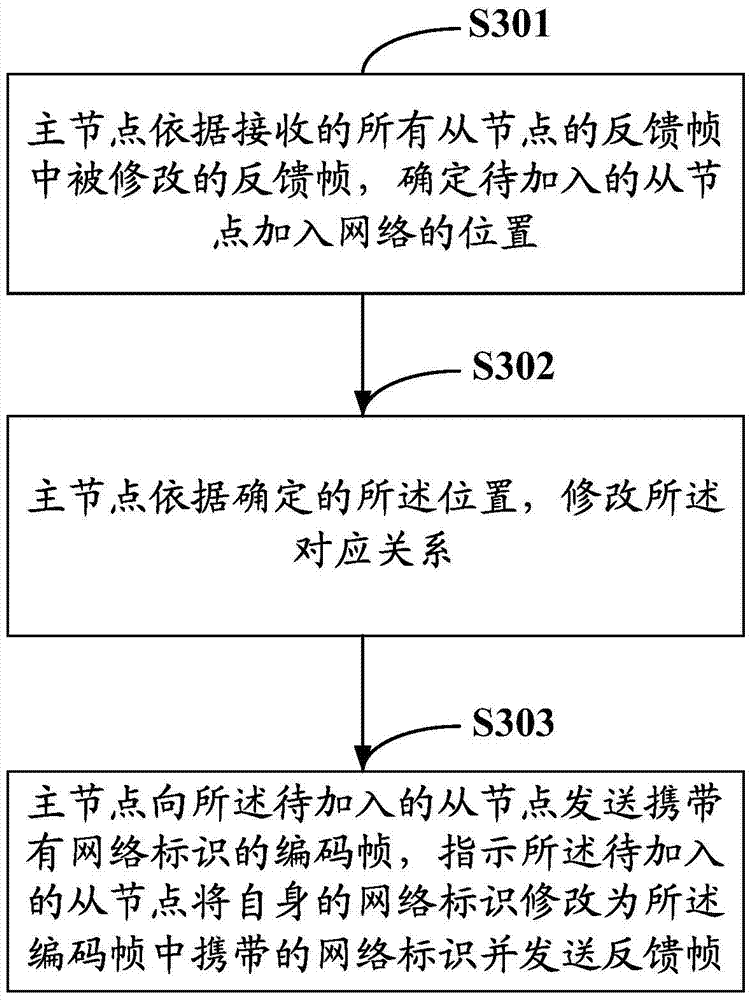A method, device and system for increasing or decreasing slave nodes in a ring communication network
A ring communication, network node technology, applied in the field of communication, can solve the problems of inability to do anything in real-time requirements, packet loss, unacceptable and other problems
- Summary
- Abstract
- Description
- Claims
- Application Information
AI Technical Summary
Problems solved by technology
Method used
Image
Examples
Embodiment 1
[0058] Embodiment 1 of the present invention provides a method for adding or removing slave nodes in a ring communication network, which can be applied to the existing HSR network or to the preferred ring communication network described above. The flow chart is as follows image 3 shown, including:
[0059] Step S301: the master node determines the position of the slave node to join the network according to the modified feedback frame received from all the slave nodes;
[0060] The to-be-joined slave node modifies the feedback frame when forwarding the feedback frames of other slave nodes.
[0061] The feedback frame can be the feedback frame sent by the other slave nodes for the command frame of the master node, or it can be the feedback frame sent by other slave nodes to the master node for other types of frames. Here, the The feedback frame is used to feed back the information of the slave node to the master node, and the master node does not need to use a special query fr...
Embodiment 2
[0087] Embodiment 2 of the present invention provides a method for adding or subtracting slave nodes in a ring communication network. The structural diagram of the ring communication network used to illustrate the method is as follows Figure 4 As shown, including a master node and 4 slave nodes.
[0088] After the system is powered on, the default network ID of the master node is 0, and the default network ID of the slave node is 255. After the self-inspection of the master node is completed, the encoding and sorting of the network is initiated through the network port B, and a network ID number is re-assigned to each slave node in sequence. The master node encodes the 4 slave nodes in sequence to establish the correspondence between the network ID and the logical ID The relational table is initialized at this time. The network connection relationship when the initialization is completed is Figure 4 shown. The correspondence table is as shown in Table (1).
[0089] ...
Embodiment 3
[0099] Based on the same inventive concept as that of Embodiment 1 of the present invention, Embodiment 3 of the present invention provides a method for adding or removing slave nodes in a ring communication network, the flow chart of which is as follows Figure 9 shown, including:
[0100] Step S901: the slave node to be added modifies the feedback frame when forwarding the feedback frame of other slave nodes;
[0101] The feedback frame can be the feedback frame sent by the other slave nodes for the command frame of the master node, or it can be the feedback frame sent by other slave nodes to the master node for other types of frames. Here, the The feedback frame is used to feed back the information of the slave node to the master node, and the master node does not need to use a special query frame to obtain the information that the slave node has joined, so it can reduce additional bandwidth overhead and improve system performance.
[0102] The modification feedback frame ...
PUM
 Login to View More
Login to View More Abstract
Description
Claims
Application Information
 Login to View More
Login to View More - R&D
- Intellectual Property
- Life Sciences
- Materials
- Tech Scout
- Unparalleled Data Quality
- Higher Quality Content
- 60% Fewer Hallucinations
Browse by: Latest US Patents, China's latest patents, Technical Efficacy Thesaurus, Application Domain, Technology Topic, Popular Technical Reports.
© 2025 PatSnap. All rights reserved.Legal|Privacy policy|Modern Slavery Act Transparency Statement|Sitemap|About US| Contact US: help@patsnap.com



